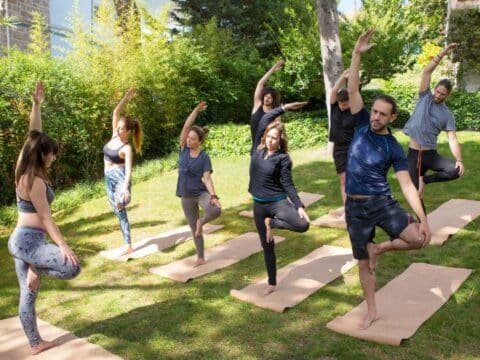The word “Yoga” comes from Sanskrit. The word means “union” or “joining together.” This ancient practice started over 5,000 years ago. It was based on the Vedas, the Vedas are texts. They contain ancient knowledge which is about the universe and consciousness.
This knowledge can lead people to understanding. It can help them understand themselves and it can break the cycle of birth and death. This wisdom can apply to disciplines and it include healing, science, art and culture.
Archaeological finds suggest yoga started as inner practice. The goal was attaining moksha or liberation. Yoga uses body movements, called asana. It uses breath control, called pranayama. These make the practitioner aware and connected. They connect the practitioner with inner consciousness.
Yoga is popular in the western world now. In the last five years, more Americans practice yoga the number has doubled. It’s now fifteen million. Three-fourths of fitness clubs offer yoga classes. So it’s no surprise Yoga was named a fast-growing exercise segment.
Yoga is not just physical, it also creates balance. The balance is in mind, emotions and consciousness. Yoga shares a goal with Ayurveda too. Ayurveda is the traditional Vedic health system.
Podcast
https://youtu.be/xwWeESAw8M8
Ayurveda
Ayurveda is a system of medicine and it is over 5,000 years old. It originated in India and it is one of the oldest systems of medicine. It is a complete system of medicine and healing. It is still practiced today.
It is often considered the Mother of all healing, because it is based on a belief. The belief is that health depends on balance and the balance is between mind, body and spirit. Its main goal is to promote good health. It does not fight disease.

Nalanda University, the oldest known university to man, was first brought to Tibet, China and the far east by monks studying there. Even today, Ayurveda’s core philosophy and practice remain almost the same as centuries ago.
The aim of Ayurveda is:
“Swasthyas swathya rakshanam”
- To protect and prolong life.
- To eliminate dysfunctions of the body.
The main focus of Ayurveda is to keep the body in harmony with nature in order to prolong life and avoid illness. According to Ayurveda, when the body is not in harmony with nature, illness and disease occur.
In the United States, practitioners of Ayurveda follow a lifestyle that is in harmony with the rhythm of the sun and moon in order to achieve a state of holistic living. Ayurveda is considered a form of complementary and alternative medicine (CAM) in the US.
Yoga & Ayurveda – Together a complete system of wellbeing?
Yoga and Ayurveda are two healing disciplines because they are closely related. They both come from India’s Vedic tradition. They have the same goal of improving health and they each have their own place and function. But they also overlap in many ways.
Ayurveda is the science. Yoga is the practice of the science.
Many yoga retreats combine yoga and Ayurveda. This is because they share principles. The principles are being in tune with the body and nature. This promotes healing. When combined, they can help cure disorders, they also rejuvenate the body. Integrating Ayurveda into yoga has great benefits.

They share the principle of balance. We have different Ayurvedic body types, called doshas. For good health, we need balance between doshas and the world. Ayurveda uses treatments and lifestyle changes. These help us find balance.
Yoga includes methods like asanas. It has breathing and pranayama. These quiet the mind. They put us in tune with nature. This achieves healing of body and mind. Different poses serve purposes in the body. They help balance doshas.
For example, forward bends pacify pitta dosha. Twists help balance kapha dosha. Backbends maintain vata dosha.
Both focus on being in tune with the body. They harness nature’s healing power. This achieves the best results.
They both have the same goal. The goal is for people to be balanced and healthy. Health is when mind, body and soul are in harmony. It’s being in harmony with the environment. Combining practices like abhyanga helps rid toxins. It relaxes muscles. It enhances wellbeing.
Both believe physical and emotional wellbeing are connected. Both embrace life. They maintain balance of mind, body and consciousness. This supports a healthy, contented life.
Yoga as Therapy
The Chikitsa Sthana has detailed instructions. It covers diagnoses, diseases, management, and therapy. This section of ancient Sanskrit texts is about treatment.
The book has two main sections. Nidana Sthana covers diagnosis. Sharira Sthana covers the embodied soul. It includes anatomy and physiology.
Ayurveda views our embodiment holistically. It sees the body, mind, and soul as interconnected. Disease causes, and treatments connect in a system. This promotes optimal health and wellbeing.

Ayurveda is comprehensive. It probes and diagnoses all aspects of life. It covers diet, herbs, drugs, and surgery. Clinical procedures like panchakarma consider mind-body links. Ayurveda looks holistically at all of life.
Ayurveda offers illness treatments. It also gives recommendations for healthy living. This prevents disease and promotes longevity. Yoga practices like asana and pranayama are healing methods too.
Yoga texts cover deep meditation and spiritual practice. They discuss yogic powers and liberation.
Yoga is not just physical. It explores consciousness, subtle energies, and spiritual practices. Yoga texts talk about meditation, concentration, mantra, ritual, pranayama, and asana. But these are part of spiritual practice, not therapy.
Chikitsa is not a major Yoga philosophy topic. Yoga texts don’t have sections on therapy or Chikitsa Padas. The term Chikitsa doesn’t occur in Patanjali’s Yoga Sutras.
Classical Yoga focuses on Sadhana, not Chikitsa. Chikitsa is Ayurveda’s domain. Yoga texts don’t discuss disease, pathology, diagnosis, or treatment strategies. There’s no distinct Yoga medicine system. It doesn’t differ from Ayurveda in diagnosis, pathology or treatment.
Yoga texts discuss pranas, senses, mind, nadis, and chakras. They talk about worshiping deities, the inner Self, and consciousness. They cover samadhi types.
Yoga texts see disease as an obstacle to practice. When it occurs, Ayurveda language is employed.
Todays Yoga Therapy
Here are some key reasons why yoga has become a popular therapy form:
Yoga therapy is considered alternative medicine. It complements other treatments instead of replacing them. Most people using yoga therapy fin d relief without prescription medications.

Studies show yoga greatly benefits physical, mental, and emotional health. It reduces stress, anxiety, and depression that can trigger illness.
Yoga boosts immune function to fight infections and disease. It builds muscle strength and improves circulation, aiding injury and surgery recovery. Yoga also develops self-discipline and motivation.
Beyond the physical, yoga meditation brings profound wellbeing. It makes people feel happier and more relaxed.
In addition, yoga can be a spiritual path to enlightenment. Proper practice connects us to our inner selves. We gain insight into life’s meaning and let go of ego and selfishness. We open to the infinite love in all things.
For chronic illnesses like arthritis, cancer and heart disease, yoga improves overall health. As an excellent workout, it burns calories and aids weight loss. The resulting energy boost helps people stay active, further relieving pain.
In summary, yoga impacts the whole person – body, mind and spirit. It brings balance, insight and a deeper understanding of life. For many, yoga becomes a spiritual journey of enlightenment.
Yogic System of Medicine?
Yoga can heal if we have a full medical system based on its philosophy and principles. This system could use asana, pranayama, pratyahara, dharana, dhyana, and samadhi as therapies. A yogic lifestyle with yamas and niyamas is also key.
Modern medicine helps physically but doesn’t fully grasp yoga for body, mind, and spirit.
We need a yogic medicine addressing physical therapy through asanas plus internal medicine and psychological issues. It would treat the whole person – body, mind and emotions.
This greater yogic medicine system already exists as Ayurveda. Ayurveda comes from Yoga and Samkhya philosophies outlining 25 principles. It is a complete Vedic, yogic medicine system.
We need healthcare providers following a yogic system covering all internal and external medicine. This includes physical and psychological wellbeing.
Integrating Ayurveda into Yoga could improve health. Ayurveda training enables communicating with modern medicine. It shows doctors how yogic healing benefits patients. This would improve health and wellness overall.
In essence, Ayurveda provides the comprehensive yogic approach to medicine needed today. It treats the whole person – body, mind and spirit. Integrating it into modern healthcare would significantly advance wellbeing.
Yoga as a Psychology
Dharana, single-pointed concentration, sustains healing practices. It develops the power of attention.
Dhyana, inward focus, promotes balance and peace of mind. This self-reflection can heal the mind and emotions.
Samadhi, the height of meditation, unites body and mind. It heightens awareness, enabling full healing and release from suffering.
Yoga’s higher aspects create the right state of mind for healing on any level.
The three internal yoga practices – dharana, dhyana and samadhi – are used in Ayurveda primarily for psychological disorders and mental health.
This view sees classical yoga therapy as focused on the mind and emotions through mantra and meditation. It is a powerful tool for healing the mind and emotions.
Connecting yoga and Ayurveda is key for yoga as therapy and medicine. It would enable better understanding of therapies and disease causes. It would show how to maintain health and wellbeing in society.
In essence, yoga’s meditative practices are powerful healing tools, especially for the mind and emotions. Combined with Ayurveda’s comprehensive approach, yoga can transform both individual and societal health.




